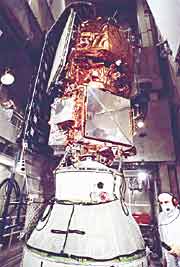A satellite is expected to fall without NASA having control over it

Photo: NASA
The satellite, before being launched from Earth. Its fragments may scatter
Scientists at the American Space Agency (NASA) estimate that a three-ton satellite, which has been cruising in space since 1992, will begin to fall towards the Earth tomorrow (Thursday) at five o'clock in the morning (Israel time) and its fragments may be scattered on the earth by tomorrow at two o'clock in the afternoon.
NASA estimates that most parts of the satellite will burn up during entry into the atmosphere, but there is a fear that parts of it will fall in different parts of the earth. Unlike previous cases, this time NASA has no control over the falling satellite.
The problem of satellites falling to Earth is not new. During the 80s and 90s, thousands of satellites were launched into space, and the American Space Command estimates that there are currently almost 9,000 satellites orbiting the Earth, of which only about 2,500 are still active. The rest of the satellites revolve around the Earth in what is considered the "space garbage can of the world".
The satellite that is supposed to fall towards the Earth during the next 24 hours is called EUVE (Extreme Ultraviolet Explorer). Its uniqueness is that its telescopes scan the sky at an ultraviolet wavelength, with the aim of locating galaxies and other space phenomena. The satellite was built at the Space Laboratory of the University of California, Berkeley, and was launched into space on June 7, 1992. In the first six months after its launch, the satellite carried out a general mapping of the sky. After completing this task, he was directed to check point phenomena determined by the scientists' choice. Towards the end of 1997, NASA decided to transfer responsibility for the satellite to the "Space Telescope Institute" - the body responsible for the scientific missions of the "Hubble" space telescope. This is to allow the academic community to use the information sent from the satellite, and even order "satellite time" to study various phenomena.
The article is from Haaretz newspaper
Fragments of a satellite may hit the Earth today between the USA and South Australia

^^Photo: NASA The satellite before it was sent into space^^
By Yuval Dror
Space / 9,000 satellites orbit the Earth, of which only 2,500 are active
Scientists at the American Space Agency (NASA) estimate that a three-ton satellite, which has been cruising in space since 1992, will begin to fall towards the Earth today at 5 am (Israel time) and its fragments are expected to be scattered on the Earth by tomorrow at XNUMX pm. NASA estimates that most parts of the satellite will burn up upon entering the atmosphere, but there is a fear that parts of it will fall in different parts of the earth. Unlike some cases in the past, this time NASA has no control over the falling satellite.
The problem of satellites falling to Earth is not new. During the 80s and 90s, thousands of satellites were launched into space, and the US Space Command estimates that there are currently almost 9,000 satellites orbiting the Earth, of which only about 2,500 are still active. The other 6,500 satellites orbit the Earth in what is considered the "junkyard of space". Some of them may crash in the future.
The satellite that should fall in the next 24 hours is called Extreme Ultraviolet EUVE (Explorer). His telescopes scanned the sky and picked up ultraviolet waves, with the goal of locating new galaxies and other phenomena in the universe.

The satellite was built at the Space Laboratory of the University of California, Berkeley, and was launched into space in cooperation with NASA on June 7, 1992. For the first six months, it was engaged in general mapping of the sky. After completing this task, he began to test point phenomena according to the scientists' choice.
Towards the end of 1997, NASA decided to transfer responsibility for the satellite to the "Space Telescope Institute" - the body responsible for the scientific missions of the "Hubble" space telescope. This is to allow the academic community to use the information coming from the satellite, and even to order "satellite time" for the study of various phenomena.
In the summer of 2000, NASA decided to end the EUVE mission, which was originally planned for only three years. Scientific use of the satellite's telescopes ended on January 26. 2001 Shortly after, on February 2, 2001, the satellite stopped operating, and then all its control systems were also disconnected.
Since then, it has been circling the Earth in a fixed orbit, slowly approaching the surface of the atmosphere. Based on the rate of approach, NASA estimates that the satellite will fall to Earth in the next day.
Since it is out of control, the scientists will only be able to know the exact point of fall of the satellite about 12 hours before the crash. In any case, it is estimated that parts of it will hit the Earth somewhere between Oregon in the USA and South Australia.
According to the project manager, Ronald Mammut, the satellite will begin to disintegrate in the atmosphere, when it reaches a height of 80 km above the earth's surface. "There is some chance that parts of the satellite will not burn up during entry into the atmosphere and harm population concentrations, but it is very small," Mamut said in a statement delivered to the US media. "It is likely that small parts of the satellite will fall into the ocean or on the ground in uninhabited places," he added.
In June 2000, NASA returned to Israel another research satellite, which was launched in April 1991. However, unlike EUVE, NASA made sure to control it until its last moments, partly because of its enormous weight - about 17 tons - which could have caused real damage, if lands in an inhabited place.
https://www.hayadan.org.il/BuildaGate4/general2/data_card.php?Cat=~~~378932475~~~86&SiteName=hayadan
